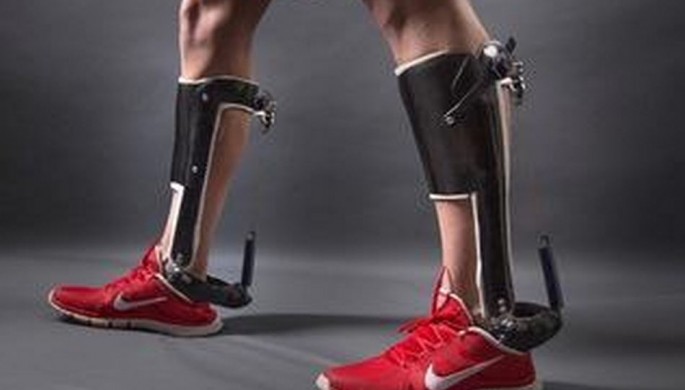A next generation, unpowered ankle exoskeleton is opening-up possibilities the "superhuman" might be possible in the mundane act of walking.
By doing away with a heavy motor and relying solely on muscle power, researchers from Carnegie Mellon University and North Carolina State University built a lightweight, unpowered ankle exoskeleton that reduces the metabolic cost of walking by some seven percent.
This means someone wearing this leg booster walks so efficiently it feels as if he were 10 pounds lighter.
When in use, the passive-elastic ankle exoskeleton has a mechanical clutch that engages when the foot is on the ground and disengages when the foot is in the air. This prevents interfering with toe clearance.
This clutch takes over the effort of the calf and produces force without using consuming any energy. The result is a reduction in the overall metabolic rate.
The research team developed a carbon-fiber design that's ultra light but tough and functional. The entire device weighs only one pound per leg, or less than a work boot.
Work is being done to improve the leg booster that has passed tests on a treadmill at 2.8 miles per hour. Researchers said they'll have to equip the leg booster with a tiny processor that adjusts the device to how fast a person is moving for it to be used in running.
Future versions of the ankle exoskeleton could lead to disabled people walking better or soldiers marching farther while humping heavy gear.
Experts describe the device is a triumph of elegance, simplicity and bio-specific interventions over complex, over-engineered designs.
"This unexpected and unprecedented result, with the potential to improve such a familiar human activity as walking, was discovered during a fundamental scientific study of mechanically augmented ankle function," said Jordan Berg, a program director at the National Science Foundation.
"It is a great example of how basic research can lead to new beneficial devices."
The unpowered ankle exoskeleton is the result of eight years of incredibly patient and smart work by Steve Collins and Greg Sawicki when they were graduate students together at the University of Michigan in 2007.
"Walking is more complicated than you might think," said Collins, now an assistant professor of mechanical engineering at Carnegie Mellon. "Everyone knows how to walk, but you don't actually know how you walk."
Collins, Sawicki and co-author M. Bruce Wiggin succeeded by performing careful analyses of the biomechanics of human walking.
They then designed a simple, ultra lightweight device that relieved the calf muscle of its efforts when it wasn't doing any productive work. The calf muscle exerts energy when propelling the body forward but also when it performs a clutch-like action, holding the Achilles tendon taut.
"Studies show that the calf muscles are primarily producing force isometrically, without doing any work, during the stance phase of walking, but still using substantial metabolic energy," said Collins.
"This is the opposite of regenerative braking. It's as if every time you push on the brake pedal in your car, you burn a little bit of gas."
Knowing this, the team developed an ankle exoskeleton that offloads some of the clutching muscle forces of the calf, reducing the overall metabolic rate.
Asked if he was talking to the military, Collins replied, "I'm not sure if I'm supposed to say ...Those conversations are ongoing, I guess."



























